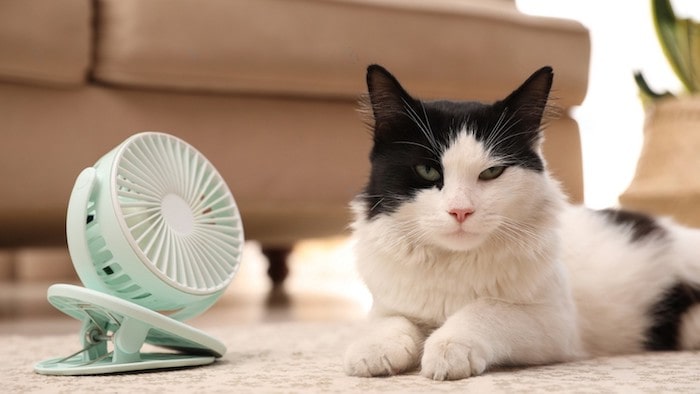As pet lovers, we all know how important it is to keep our furry friends happy and healthy. We spoil them with treats, toys, and snuggles, and sometimes even let them take over our beds. But have you ever stopped to think about your cat’s preferred temperature?
That’s right, just like us, our feline companions have their own unique preferences when it comes to heat and cold. And if you’ve ever caught your kitty shivering or panting excessively, you’ll know that it’s not just a matter of comfort, it can affect their health and well-being too!
But don’t worry, we’ve got you covered. In this article, we’re going to dive into the fascinating world of cat temperatures. We’ll explore everything from what factors affect their preferred temperature range, to how to tell if your cat is feeling too hot or cold. So get ready to learn all about how to keep your cat feeling cool as a cucumber (or cozy as a kitten, depending on the season). Let’s jump in!
Understanding a Cat’s Natural Temperature Preferences
Cats, like humans, have their own individual temperature preferences. However, there is a general temperature range that most cats find comfortable.
The preferred temperature range for cats is typically 68 to 80 degrees Fahrenheit (20 to 27 degrees Celsius), which is similar to what humans consider comfortable. However, cats can withstand a slightly warmer environment because their body temperature is around 101.5 degrees Fahrenheit or 38.6 degrees Celsius.
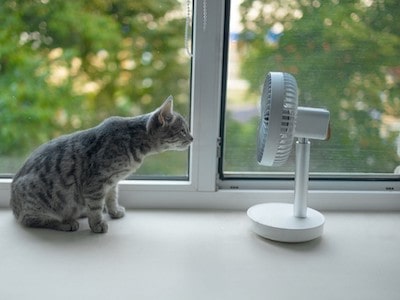
A cat’s temperature preferences can be impacted by various factors, including age, health, breed and coat length. In order to prevent overheating, a long-haired cat may prefer cooler temperatures whereas an elderly or sickly feline might opt for warmer conditions to remain comfortable.
Gradual temperature adjustment is recommended to prevent discomfort or distress in cats as sudden changes in temperature, whether inside or outside, can cause stress to them.
Observing your cat’s behavior is ultimately the best way to determine their preferred temperature. If they exhibit lethargy or excessive panting, it may indicate that they are too hot. Conversely, if they seek out warm spots or shiver, it could mean that they are too cold. Providing an environment that meets your cat’s needs and paying attention to their behavior can help ensure their comfort and overall well-being.
Signs that Your Cat is Too Cold or Too Hot
Being a responsible pet owner requires you to stay alert for signs that your cat is either too cold or too hot. Uncomfortable and hazardous conditions can result from extreme temperatures, so it’s crucial to take prompt action if any discomfort indicators are noticed. The following are typical symptoms that indicate your feline may be experiencing excessive warmth or chilliness:
Too Cold:
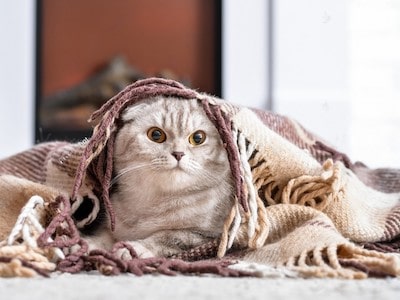
- Shivering or shaking
- Curling up into a tight ball or seeking out warm spots
- Cold ears or paws
- Lethargy or lack of energy
- Loss of appetite
To ensure your cat’s comfort, it’s crucial to give them a cozy environment if they’re showing any of these symptoms. This may involve providing a warm sleeping spot, blankets, or even a heating pad (kept at low heat and covered with a towel to avoid burns).
Too Hot:
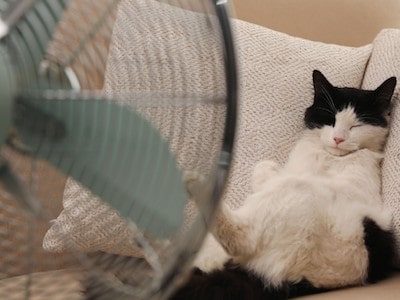
- Panting or rapid breathing
- Seeking out cool spots or lying on cool surfaces (such as tile floors)
- Lethargy or lack of energy
- Loss of appetite
- Red or warm ears and paws
If your cat is exhibiting any of these signs, it’s important to provide them with a cool and comfortable environment. This can include providing a cool, shaded area to rest in, ensuring that there is good ventilation, and providing plenty of fresh water to drink.
In either case, if you notice persistent or severe signs of discomfort, it’s important to consult with a veterinarian. They can help determine if there is an underlying health issue that needs to be addressed.
Factors that Affect a Cat’s Temperature Preferences
There are a variety of factors that can affect a cat’s temperature preferences. Here are some of the most common factors to consider:
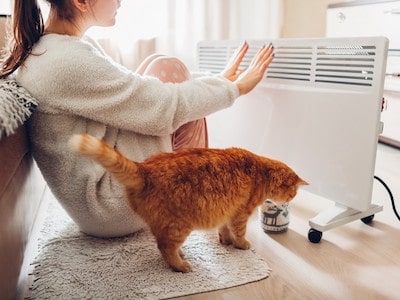
- Age: As cats get older, they may become more sensitive to temperature changes. Elderly cats may require warmer temperatures to stay comfortable, while kittens may need warmer temperatures to regulate their body heat.
- Health: Cats with health issues may have different temperature preferences than healthy cats. For example, cats with thyroid issues may prefer cooler temperatures, while cats with arthritis may prefer warmer temperatures.
- Coat Length: Cats with long or thick coats may have a harder time regulating their body temperature and may prefer cooler temperatures. Short-haired cats may prefer warmer temperatures to stay comfortable.
- Breed: Certain cat breeds may have specific temperature preferences based on their natural habitat. For example, breeds that originated in colder climates may prefer cooler temperatures, while breeds from warmer climates may prefer warmer temperatures.
- Environment: Cats who spend most of their time indoors may have different temperature preferences than cats who spend time outdoors. Indoor cats may be more accustomed to consistent indoor temperatures and may be more sensitive to temperature changes when they go outside.
- Time of Day: Cats may have different temperature preferences depending on the time of day. For example, cats may prefer cooler temperatures during the day when they are more active and warmer temperatures at night when they are resting.
How to Help Your Cat Adjust to Different Temperatures
Cats can be sensitive to sudden changes in temperature, and it’s important to help them adjust to new environments to prevent discomfort and stress. Here are some tips for helping your cat adjust to different temperatures:
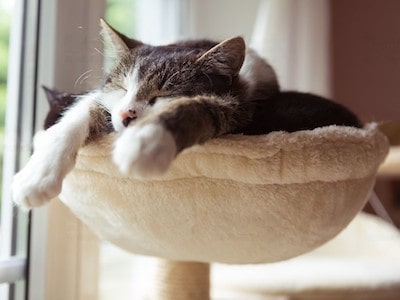
- Gradually adjust the temperature: If you want to move your cat to a new home or alter the temperature in your existing home, it is crucial that you do so gradually. Take small steps over several days to allow your cat time to acclimate to the new temperature.
- Provide a comfortable environment:Ensure that your cat can reach a cozy bed, blankets, and other objects that aid in regulating their body temperature. Additionally, you could offer a heating pad or cooling mat to ensure they remain comfortable during extreme weather conditions.
- Monitor their behavior: Be observant of any indications that your cat might be experiencing excessive heat or coldness, such as heavy breathing or trembling. In case you observe any manifestation of unease, regulate the temperature accordingly.
- Provide access to fresh water:It is important for cats to have unrestricted access to clean, fresh water, particularly during periods of extreme weather conditions. Ensure that your cat’s water dish remains continuously replenished with fresh drinking water.
- Adjust their diet: Your cat’s energy requirements may vary in harsh temperatures. Altering their diet can assist them in managing their energy levels and maintaining body temperature. Consult your veterinarian regarding dietary modifications for your feline companion.
FREQUENTLY ASKED QUESTIONS
Can cats tolerate extreme temperatures?
Cats can tolerate a range of temperatures, but extreme temperatures can be dangerous and uncomfortable for them. It’s important to provide your cat with a comfortable environment that meets their temperature preferences.
What should I do if my cat seems uncomfortable in the temperature of my home?
If your cat seems uncomfortable in the temperature of your home, you can make adjustments such as providing additional blankets or moving their bed to a warmer or cooler area. If your cat continues to seem uncomfortable, consult with your veterinarian to rule out any underlying health issues.
Can a cat’s coat length affect their temperature preferences?
Yes, a cat’s coat length can affect their temperature preferences. Cats with longer or thicker coats may prefer cooler temperatures, while cats with shorter hair may prefer warmer temperatures.
Can outdoor cats adjust to changes in temperature?
Yes, outdoor cats can adjust to changes in temperature, but they may need additional resources such as a warm shelter or access to cool, shaded areas to rest in. It’s important to monitor your outdoor cat’s behavior and make adjustments to their environment as needed to ensure their comfort and health.
Conclusion
Cat owners should be aware that a cat’s temperature preferences are influenced by different factors, including age, health status, and surroundings. It is crucial to observe your cat’s behavior and offer an environment that meets their temperature requirements.
You can ensure the comfort and wellness of your pet by being attentive to signs of discomfort and modifying the environment accordingly. If you have any uncertainties regarding your cat’s wellbeing or behavior towards temperatures, seek guidance from a veterinarian for support. By providing proper care and attention, you can guarantee the long-term happiness and healthiness of your feline companion.

